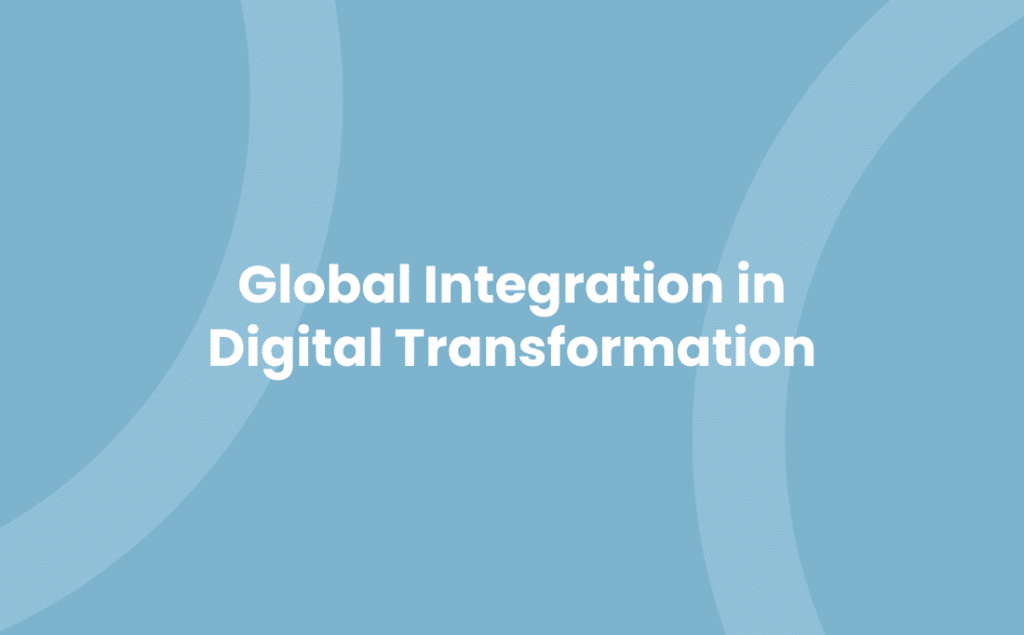In the ever-evolving world of business, you’re likely hearing the buzzwords “Digital Transformation” more frequently. But what does it really mean, and how does it impact global market integration? Let’s delve into these intriguing concepts.
Digital Transformation isn’t just a trend; it’s a critical shift that’s reshaping industries globally. It’s about leveraging digital technologies to revamp business operations, customer interactions, and overall value delivery. On the other hand, global market integration is a complex process, intertwining economies and markets worldwide.
In this article, we’ll explore the intersection of these two phenomena, providing insights into how Digital Transformation is driving global market integration and what it means for businesses like yours. So, buckle up and prepare for an enlightening journey into the digital age.
Understanding the Concept of Digital Transformation
Digital Transformation presents itself as a radical rethinking of how businesses utilise digital technology. It typically begins with a shift from analogue or manual processes to digital ones, going beyond digitalisation which simply automates existing processes. For your business to thrive in this transformation, master the art of integrating digital technology into all areas of your business.
In a broader sense, Digital Transformation concerns the usage of digital technology in different aspects of human society. It opens up myriad possibilities, from enhancing operational efficiency in businesses to improving societal issues such as healthcare accessibility or education.
A monumental part of Digital Transformation lies in its ability to break boundaries. Companies now find themselves in a position to access the global market. Integrating digital strategies into your business model can enable you to make this leap, offering your products or services far beyond your geographical sector. Thus, the impact of Digital Transformation extends to global market integration.
Nonetheless, Digital Transformation does not merely revolve around introducing fresh digital technologies. It’s a transformation of culture where businesses require constant experimentation and comfortable with failure. This culture induces a paradigm shift within the organisation, leading to employees adopting a digital mindset that embraces innovations.
Undoubtedly, the concept of Digital Transformation may seem overwhelming, especially with its extensive range, from AI to cloud computing, Big Data, and so much more. Recognise that it’s a gradual process, not an overnight change. Start small, understand the impact of each transformation process, and scale up.
Finally, remember that at the heart of Digital Transformation lies the ambition to enrich customer experience and meet changing business and market requirements. Thus, keep an eye on both internal processes and external outcomes while steering your business on this transformative journey. This approach pivotal to maximise potential advantages while also minimising potential setbacks in your endeavour towards embracing the global market.
Global Market Integration: An Overview
In the throes of digital transformation, global market integration stands as an advantageous development. Global market integration refers to the unification of different markets across the world, consolidating practices and forging a potent universal business ecosystem.
Digital technology drives global integration, removing geographical constraints, and establishing interconnectedness in an international market scenario. Uniform digital platforms serve to simplify processes, creating harmonious systems of business operations across varied market areas. Advanced tech tools, such as Cloud computing platforms and AI algorithms, serve to integrate global markets seamlessly.
Primarily, Digital transformation facilitates ease of data sharing. Instant digital connections enable swift, efficient communication amongst participants of different markets. Collaborative efforts no longer ride on time-consuming traditional methods, fostering immediate decision-making and expedited results.
Moreover, digital integration lessens trade barriers, opening up avenues for consumption and competition at a global level. The boundless reach of digital networks extends the platform of offerings, enabling a diverse selection of goods and services. This digital interconnection aids in standardising prices worldwide, stabilising the international economy.
Furthermore, Digital transformation precipitates the evolution of business models, reinventing traditional forms to suit an ever-progressing global market. This digital integration encourages a shift from parochial, localised business perspectives to all-encompassing global strategies. Businesses adopt and adapt to these ever-evolving models, eagerly partaking in the international circuit powered by digital tools.
Grasp an understanding of the global market integration; it’s a key ingredient in the recipe for successfully embarking on the voyage of Digital Transformation. The journey demands a persistent commitment; to keep adapting, evolving and rising to the standards of a unified market, amplified by the power of digitisation.
Remember, integrating into the global market isn’t mere participation. It’s an active, ongoing contribution towards the contours of a consolidated, thriving international business sphere, bolstered by the robust potency of digital transformation.
Role of Digital Transformation in Global Market Integration
Digital transformation commits a key role in promoting global market integration, facilitating a cohesive marketplace. In this game-changing era, it’s essential for businesses to understand its criticality.
Digital Transformation proves instrumental in eliminating geographical barriers. Through digital channels, businesses can cater to a global audience with ease, thus integrating international markets. High-speed internet connectivity, user-friendly digital platforms, and sophisticated communication tools enable real-time interaction, bridging the gap between businesses and consumers across the globe.
Moreover, digital transformation aids in standardising business processes. Companies adopt universal software applications and automated solutions, leading to homogenisation of operational procedures. Such standardised systems foster efficiency, reducing disparities in price and quality, and encouraging global market integration. For instance, widespread adoption of cloud computing creates a shared digital workspace that facilitates the exchange of information, encourages collaboration, and ultimately, spurs global market integration.
Likewise, leveraging Big Data and AI algorithms, businesses not only gain insights into market trends but also anticipate customer behaviour worldwide. It allows them to customise their offerings and marketing strategies suiting international preferences.
Lastly, digital transformation enhances transparency in global markets. Blockchain technology, specifically, offers a secure digital platform for conducting transparent, trustworthy transactions across borders. It’s a revolutionary tool that combats fraud, ensures compliance with international standards, and enhances global trading efficacy.
With the swift advancement in technology, global market integration via digital transformation isn’t a distant dream. Businesses that adopt and adapt to these innovative digital practices find themselves ahead of the curve in the integrated global marketplace. As your business embarks on its journey towards digital transformation, it’s paramount to recognise and seize the opportunities brought forth by this globally integrated market.
Challenges in Digital Transformation and Global Market Integration
When integrating digital transformation into the global market, various obstacles may come into play. Understanding these hindrances is essential for smooth operations and overcoming the hurdles posed by technology and market integration.
- Resisting Change: Employees often resist change. Digital transformation involves introducing new technology, altering workflow and, sometimes, reshaping the organisation’s culture. Employees might feel threatened by these changes, fearing job loss and increased workload.
- Cybersecurity Concerns: With the introduction of technological tools like AI and cloud computing, the risk of cyber threats increases. Data breaches, hacking, and other cybercrimes pose significant challenges to the incorporation of digital transformation into the global market.
- Technological Interoperability Issues: Companies across the globe use different technologies. Ensuring the seamless integration of these diverse tech stacks can be a complex task.
- Legal and Regulatory Compliance: Different countries have varying regulations around data and privacy. Navigating this maze of laws across geographies can be complex and might impede the process of global market integration.
- Aligning Goals with the Market and Business Needs: One major challenge is aligning digital transformation initiatives with both market demands and specific business goals. Having an in-depth understanding of this alignment helps businesses thrive in an integrated global market.
- Scalability Issues: Businesses need to ensure that their digital transformation initiatives can scale up with their growth and expansion. This scalability challenge is even more prominent in the context of global market integration.
These are some of the primary challenges your business may face when embracing digital transformation in an integrated global market. Overcoming these obstacles requires strategic planning, constant monitoring and adaptability. It’s crucial to remember that digital transformation isn’t a one-time process, but a continual evolution along with the ever-changing global market trends.
Strategies to Drive Digital Transformation and Promote Global Integration
Driving digital transformation in your business and fostering global integration involves a thoughtful mix of strategic planning, streamlined implementation techniques, and harnessing the power of data-driven decisions. There’s no one-size-fits-all recipe, but some universal principles apply.
- Establish Clear Goals: Clarify your global integration and digital transformation objectives upfront. They could encompass enhancing customer experience, improving operational efficiency, or tapping into new markets. Stated target outcomes dictate the transformation pathway.
- Adopt Across-the-board Digitisation: A holistic approach to digitisation streamlines workflows, reduces risk and secures growth. It’s not about piecemeal software upgrades but a comprehensive digital overhaul – from data management to customer service.
- Adapt Culture Matters: Embrace a digitally savvy culture to counter resistance to change. Empowering your team with requisite digital skills, from basics to deeper technical knowledge, fosters readiness for transformation.
- Invest in Cybersecurity: Cybersecurity protects your digital assets and builds customer trust. Make it a cornerstone of your strategic framework.
- Pilot Programs and Iterative Approach: Test the waters before diving right in. An innovative, iterative approach can help assess the efficacy of new digital tools. Learn from failures, optimise, and adapt your strategies as necessary.
- Scale with Caution: Aggressively scaling can strain your resources. Consider a gradual rollout, ensuring systemic stability and readiness.
- Adherence to Regulatory Standards: Respect international norms, privacy laws and data regulations. Keep abreast of changes and maintain compliance.
- Partnerships and Collaborations: Leverage collective strengths through strategic alliances and partnerships to heighten the impact of your digital efforts.
Implement these strategies assiduously, remember, digitising your business for global integration is a marathon, not a sprint. Continual assessment and adaptation of your digital strategy can ensure you stay ahead in the increasingly competitive global market.
Measuring the Impact of Digital Transformation on Global Market Integration
To accurately assess the impact of digital transformation on global market integration, you focus on several key performance indicators (KPIs). These KPIs offer insights into crucial aspects of market dynamics and provide a framework for effective measurement and analysis.
Examine revenue growth, for instance, with digital transformation global market integration often goes hand in hand with an increase in revenues. By digitising operations and establishing a powerful online presence, businesses tap into larger markets, intensifying sales beyond traditional local and regional boundaries.
Focus also on your efficiency metrics. Digital transformation paves the way for smoother processes, using technology to automate routine tasks. This streamlining translates into decreased operational costs and swifter turnover times – two significant markers of efficiency that directly affect your bottom line.
Measure your change in customer base. A clear sign of successful global market integration is an expanding international customer base. Evaluating your customer demographics and geographical reach allows you to assess your progress in penetrating global markets.
Analyse customer engagement. The level of customer interaction and engagement often shoots up with comprehensive digital transformation. By using social media platforms, websites, and e-commerce channels, companies enhance their interaction with customers, foster brand loyalty, and increase customer retention rates.
Finally, review your cybersecurity metrics. With the expansion of business into the digital realm, cyber threats pose significant risks. Hence, it’s essential to monitor cyber threat incidents and their mitigation – an indirect reflection on the successful digital transformation.
In essence, to understand the effect of digital transformation on the ebb and flow of global market integration, you require involvement in a continuous process of measurement, evaluation, and adaptation.
The Future of Digital Transformation and Global Market Integration
Brace yourself; the future of digital transformation and global market integration is a fast-approaching reality. Companies embracing this revolution are already seeing the fruits of their labour blossom.
Advanced technologies like Artificial Intelligence, Cloud Computing, Internet of Things (IoT), and Big Data form the core of this transformation. These technologies serve as keys unlocking a trove of operational and strategic benefits:
Better Business Intelligence: Imagine harnessing the power of big data insights to make accurate predictions about market trends. Businesses can ride the wave of these trends ahead of their competition, positioning themselves advantageously in the global market.
Increased Efficiency: The integration of IoT allows businesses to streamline their operations by automating repetitive tasks. For instance, a manufacturing company can use IoT sensors to monitor equipment performance, preventing costly breakdowns through predictive maintenance.
Enhanced Customer Experience (CX): By deploying AI-powered chatbots, businesses can provide round-the-clock customer support, resulting in an improved CX which can catapult a brand on a global stage.
Perhaps the most exciting prospect lies in the digital economy’s potential for market integration. As companies digitise, borders blur and markets merge, creating a truly international marketplace. This market integration presents a whole new ball game of opportunities, albeit, tallied alongside risk.
Indeed, cybersecurity risks pose prominent challenges in this interconnected cyber world. Criminals exploit vulnerabilities in the system, the rising number of cyber-attacks attest to this. However, companies aren’t sitting ducks. In fact, businesses are fortifying their digital fortresses with top-tier cybersecurity measures, essentially turning their vulnerabilities into strengths.
Regulation also plays a pivotal role in this arena. As markets integrate, international regulatory practices become more critical than ever before. Navigating legal landscapes across jurisdictions can be tricky, but for businesses determined to reap the fruits of global integration, it’s a challenge worth facing.
Going forward, the age of digital transformation and global market integration will spur more innovation, market growth, and improved efficiency. It’s clear that the digital realm doesn’t only provide a competitive edge, it becomes the competitive playing field. So, for those of you preparing for this future, remember, in the world of digital transformation, adaptability trumps all.
Conclusion
So you’ve seen how Digital Transformation is revolutionising industries. It’s not just about integrating technology into operations, but also about overcoming challenges like employee resistance and cybersecurity issues. The future of this transformation, coupled with Global Market Integration, is brimming with potential. Advanced technologies like AI, Cloud Computing, IoT, and Big Data are poised to offer operational and strategic benefits. They’re paving the way for better business intelligence, increased efficiency, and enhanced customer experiences. And in a globally connected marketplace, cybersecurity and regulatory compliance can’t be overlooked. But remember, adaptability is key. Businesses must be ready to evolve with the digital landscape to truly thrive. It’s a brave new world out there, and it’s yours for the taking.



